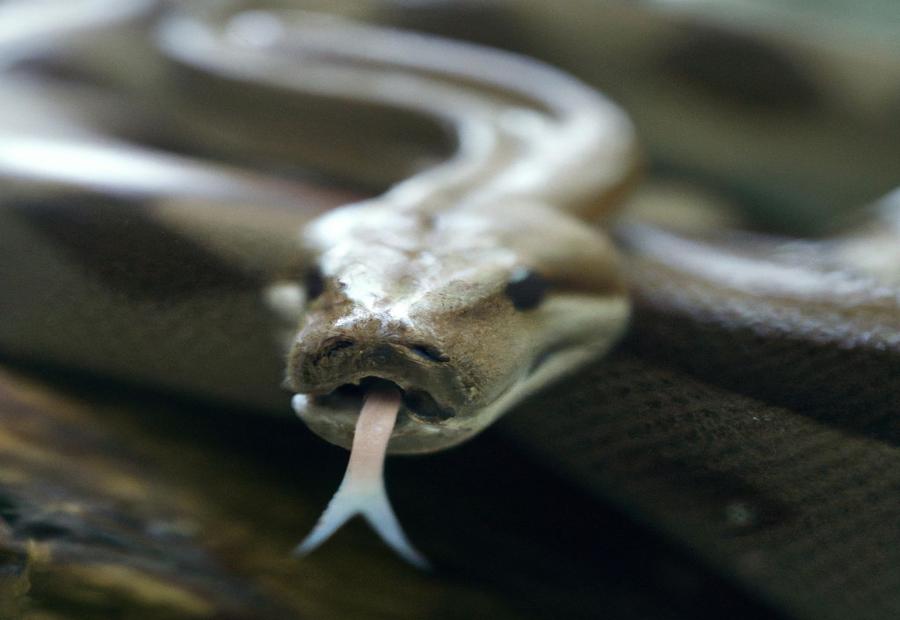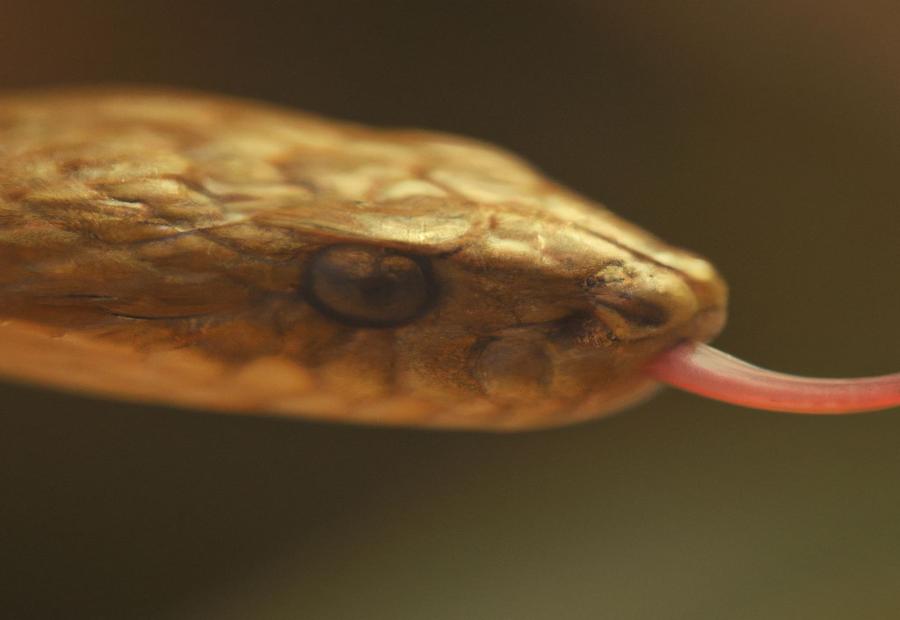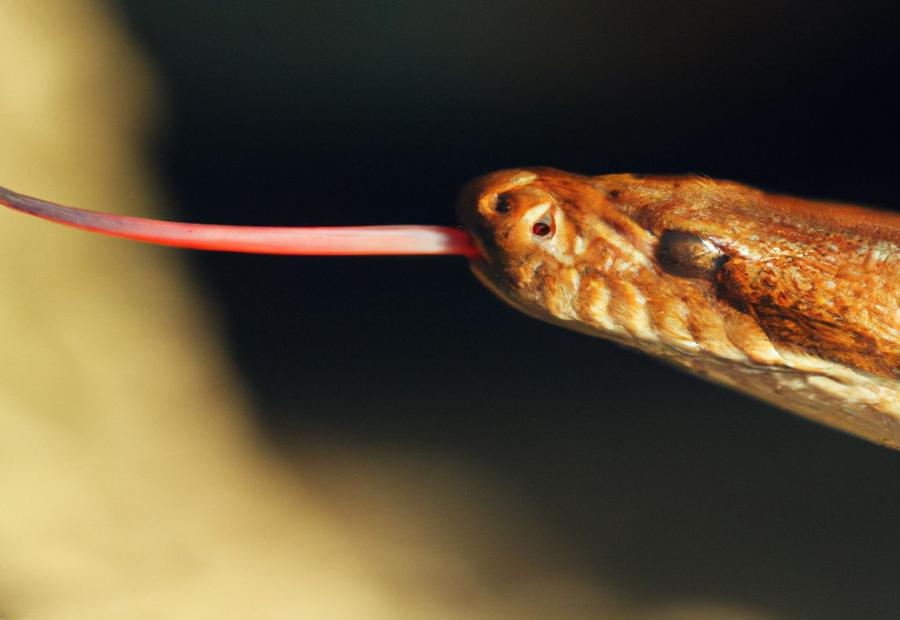Snakes, often surrounded by myths and misconceptions, possess a remarkable sense of smell that is vastly different from that of humans and other animals. In order to dispel these misconceptions and gain a deeper understanding of how snakes actually smell, it is important to explore the intricacies of their olfactory system. By examining their unique sensory organs and chemical sensing abilities, we can appreciate the vital role that smell plays in the lives of these fascinating creatures, helping them find prey, avoid predators, and communicate during reproduction. This article aims to debunk common misconceptions about snakes’ sense of smell and shed light on the fascinating reality of how they utilize this sensory ability. Ultimately, gaining a better understanding of snakes’ amazing sense of smell can lead to a greater appreciation for these often misunderstood reptiles.
(‘n
Key takeaway:
n
- Snakes have a highly developed sense of smell: Contrary to common misconceptions, snakes possess a remarkable olfactory ability that allows them to detect and interpret odors in their environment.
- Jacobson’s Organ: The key to snakes’ sense of smell: Snakes have a unique organ called Jacobson’s organ, located in the roof of their mouths, which enables them to detect and analyze chemical signals in the air.
- Snakes rely on smell for essential activities: Snakes utilize their sense of smell for vital tasks such as finding prey, avoiding predators, and communicating for reproduction. Appreciating the importance of their olfactory abilities is crucial in understanding their behavior and biology.
n
n
n’)
Common Misconceptions about Snakes’ Sense of Smell

Photo Credits: Ruggedreptiles.Com by Jack Green
Think you know everything about snakes’ sense of smell? Well, think again! In this eye-opening section, we’re about to debunk some of the most common misconceptions surrounding snakes’ olfactory abilities. Brace yourself as we explore the truth behind three fascinating sub-sections: the myth that snakes cannot smell at all, the intriguing role of their tongue in smelling, and the surprising comparison of their olfactory capabilities with other animals. Get ready to have your snake knowledge turned upside down!
1. Snakes Cannot Smell at All
Snakes have a highly developed sense of smell, contrary to the misconception that snakes cannot smell at all. They possess a specialized organ called the Jacobson’s organ, located in the roof of their mouth, which is essential for their olfactory abilities. When a snake flicks its tongue, it collects scent particles from the air or ground, which are then transferred to the Jacobson’s organ for analysis. Through this unique method of chemical sensing, snakes are able to detect odors and identify potential prey, predators, or mating partners. Snakes rely on their sense of smell to navigate their surroundings and fulfill their basic biological needs. It is important to recognize and appreciate the complexity of their sensory perception and dispel the misconception that snakes cannot smell at all.
2. Snakes Use Their Tongue to Smell
Snakes use their tongue to smell, but it’s not the main method of olfaction. The tongue collects odor particles and transfers them to the Jacobson’s organ in the roof of their mouth. This organ analyzes the particles and sends signals to the snake’s brain to interpret the odors. By flicking their tongue and utilizing the Jacobson’s organ, snakes have developed a remarkable sense of smell for survival and hunting. It is the Jacobson’s organ that enables them to process and interpret odors from their surroundings. Understanding this aspect of snake biology helps dispel the misconception that snakes rely solely on their tongue for smelling.
On a related note, traditional Chinese medicine used dried snake tongues for treating various ailments. This historical use highlights the significance of these unique organs in human perception and cultural beliefs.
3. Snakes Have a Poor Sense of Smell Compared to Other Animals
Snakes have a highly developed sense of smell, although it is different from that of mammals. Contrary to the belief that snakes have a poor sense of smell compared to other animals, they actually possess a specialized organ called Jacobson’s organ located on the roof of their mouth. Using this organ, snakes can detect and analyze chemical cues in the environment.
Snakes also use a unique method of detecting odors through chemical sensing. They collect scent particles with their tongues and transfer them to the Jacobson’s organ for analysis, allowing them to detect prey, predators, and potential mates.
Additionally, snakes exhibit various smell-related behaviors to demonstrate their olfactory abilities. They use their sense of smell to locate prey, navigate their surroundings, and communicate during courtship and mating. Therefore, it is inaccurate to claim that snakes have a poor sense of smell compared to other animals.
The Reality: How Snakes Actually Smell

Photo Credits: Ruggedreptiles.Com by Donald Wilson
Curious about how snakes actually smell? Delve into the fascinating world of snake olfactory abilities in “The Reality: How Snakes Actually Smell” section. From Jacobson’s Organ, the key to their olfactory prowess, to their unique method of chemical sensing, this section uncovers the secrets behind snakes’ uncanny ability to detect odors. Brace yourself for intriguing insights into their smell-related behaviors, offering a glimpse into the remarkable olfactory world of these slithering reptiles.
1. Jacobson’s Organ: The Key to Snakes’ Olfactory Abilities
Snakes have a remarkable olfactory system, thanks to their highly developed and specialized organ known as Jacobson’s organ. This unique organ, located in the roof of their mouth, allows snakes to detect and analyze scents in their surroundings.
Unlike humans, snakes do not use their nostrils to inhale and exhale air. Instead, they utilize a fascinating method by flicking their tongues in the air to collect scent particles. These collected particles are then transferred to Jacobson’s organ for thorough analysis. Due to its high sensitivity, this organ enables snakes to detect even the faintest traces of scent.
Through the remarkable Jacobson’s organ, snakes are able to gather important information about their environment. They heavily rely on their sense of smell to locate prey, avoid predators, and communicate with other snakes. This organ plays a vital role in their hunting strategies, survival techniques, and even reproductive behaviors.
Understanding the significance of Jacobson’s organ allows us to truly appreciate the impressive olfactory abilities of snakes. It also dispels the misconception that snakes have a poor sense of smell compared to other animals.
Pro-tip: When encountering a snake in the wild, it is important to remember that they heavily rely on their sense of smell. To avoid startling them, it is advisable to minimize your scent by avoiding the use of strong perfumes or soaps.
2. Chemical Sensing: Snakes’ Unique Method of Detecting Odors
Snakes have a unique method of detecting odors called chemical sensing. This process involves their Jacobson’s organ, which is located in the roof of their mouths. Through chemical sensing, snakes are able to collect chemical particles using their forked tongues and then transfer them to the Jacobson’s organ for analysis. This allows snakes to perceive scents in greater detail and detect specific odors such as prey, predators, and other snakes. Chemical sensing plays a crucial role in the survival, reproduction, prey finding, danger avoidance, and mate location of snakes. This remarkable ability sets snakes apart and enhances their sense of smell.
3. Smell-Related Behaviors in Snakes
Snakes exhibit three important smell-related behaviors for their survival and interactions with the environment. These behaviors consist of hunting, marking territory, and finding mates.
-
Hunting: Snakes rely on their exceptional sense of smell to locate prey. They utilize their Jacobson’s organ, which enables them to detect chemical signals in their surroundings. This sensory ability assists them in identifying potential meals and enhancing their hunting proficiency.
-
Marking territory: Snakes employ their sense of smell to establish their presence within a specific area. They release pheromones, indicating their existence and dominance. Other snakes can perceive these chemical indicators, which helps prevent conflicts and enables them to claim their own territories.
-
Finding mates: Snakes depend on their sense of smell to locate potential mates. Female snakes emit pheromones that attract males, who can detect these signals from a distance. This enables them to locate and court potential mates, ultimately ensuring successful reproduction.
These scent-related behaviors are of utmost importance for the survival and procreation of snakes. They aid in finding nourishment, establishing territories, and locating suitable partners. Understanding the significance of these behaviors dispels the misconception that snakes possess a weak sense of smell compared to other animals. Snakes possess unique adaptations that greatly enhance their olfactory capabilities in their natural habitats.
Exploring the Importance of Snakes’ Sense of Smell
Curious about the hidden world of snakes and their remarkable sense of smell? In this eye-opening section, we’ll dive into the importance of snakes’ sense of smell and uncover intriguing insights into their hunting strategies, survival techniques, and olfactory communication for reproduction and mating. Prepare to be amazed by the fascinating ways in which snakes utilize their keen sense of smell to navigate their surroundings and thrive in the wild. No wonder these slithering creatures have captivated our curiosity for centuries!
1. Finding Prey: Snakes’ Hunting Strategies
When it comes to finding prey, snakes utilize various hunting strategies for survival. These strategies include:
- Ambush: Snakes blend in and patiently wait for prey to pass by, relying on their camouflage and senses.
- Constriction: Pythons and boas wrap around their prey and squeeze until it suffocates, which is effective for larger prey.
- Venomous Strike: Vipers and cobras immobilize their prey with venomous bites, making it easier to capture and consume.
- Burrow Hunting: Some snakes, like the sand boa, use their sense of smell and touch to locate prey hiding in burrows.
- Camouflage and Stealth: Snakes that rely on camouflage and stealth approach their prey undetected and strike to capture.
Fun Fact: Snakes are patient hunters, sometimes waiting hours or even days for the perfect moment to strike and catch their prey.
2. Avoiding Predators: Snakes’ Survival Techniques
Snakes have effective survival techniques to avoid predators. Here are the strategies they use:
-
Camouflage: Snakes blend in with their surroundings by using their coloration and patterns. This makes it difficult for predators to spot them.
-
Hiding and Burrowing: Snakes find hiding places and burrow into the ground or under vegetation to avoid predators. They can quickly disappear into small crevices or hide in dense foliage.
-
Fast and Agile Movements: Snakes are incredibly agile and can move swiftly to escape from predators. They can slither quickly through grass and vegetation.
-
Warning Signals: Some snake species have developed warning signals to deter predators. They may display bright colors or patterns, mimic venomous snakes, or make loud hissing noises to intimidate predators.
-
Mimicry: Some non-venomous snake species have evolved to mimic venomous snakes. This deters predators that are wary of the venomous species.
Remember, if you encounter a snake in the wild, it’s best to give it space and avoid approaching. Snakes prefer to avoid human contact and will usually retreat if given the chance.
3. Reproduction and Mating: Snakes’ Olfactory Communication
Snakes’ olfactory communication plays a crucial role in their reproduction and mating. During this process, male snakes utilize their olfactory abilities to release pheromones, chemical signals that serve to attract potential mates. Meanwhile, female snakes rely on their ability to analyze these pheromones in order to assess the suitability of potential partners.
Once a male snake is identified through his pheromones, courtship rituals ensue. Additionally, male snakes may leave a scent trail for females to follow, ensuring successful mating. Appreciating the significance of snakes’ sense of smell allows us to understand their mating behaviors and the role of olfactory cues in their reproductive processes.
Notably, researchers have even observed snakes utilizing their sense of smell to locate potential mates from long distances, highlighting the remarkable olfactory communication skills demonstrated during reproduction and mating.
Dispelling Other Myths about Snakes

Photo Credits: Ruggedreptiles.Com by Willie Young
Snakes and their sense of smell have been the subjects of many myths and misconceptions. In this section, we’ll set the record straight by dispelling some of these common fallacies. Prepare to be surprised as we explore two intriguing sub-sections: 1. Snakes Are Attracted to Certain Scents and 2. Snakes Can Smell Fear. Get ready to uncover the fascinating truths behind these snake-related beliefs and deepen your understanding of these remarkable creatures.
1. Snakes Are Attracted to Certain Scents
Snakes are not attracted to specific scents, but they do use their sense of smell to detect prey, predators, and potential mates. Their sense of smell, which is enhanced by their olfactory system, including the Jacobson’s organ, allows them to locate food sources. While certain scents may catch a snake’s attention, they do not have a strong preference for specific scents like humans or other animals do. Instead, snakes rely on their sense of smell to gather important information about their surroundings, such as food, threats, and mates. These olfactory abilities are crucial for the survival and reproductive strategies of snakes.
2. Snakes Can Smell Fear
Snakes possess a remarkable sense of smell. They use their highly sensitive Jacobson’s organ to detect and analyze chemical signals in their environment.
While they can detect various scents, there is no scientific evidence to suggest that snakes can specifically smell fear in humans or other animals.
Snakes rely on their sense of smell to locate prey, detect predators, and communicate with other snakes for mating purposes.
It is important to dispel the myth that snakes are attracted to fear. Snakes respond to specific chemical signals associated with prey or potential threats, rather than emotional states such as fear.
Understanding the truth about snakes’ sense of smell allows us to appreciate their amazing adaptations without perpetuating unfounded fears or misconceptions.
Some Facts About Debunking Misconceptions About Snakes’ Sense of Smell:
- ✅ Snakes use their tongues to pick up scents in the air. (Source: askdruniverse.wsu.edu)
- ✅ The Jacobson’s organ in the roof of a snake’s mouth helps decode scents. (Source: askdruniverse.wsu.edu)
- ✅ Snakes have a vomeronasal system that uses their tongue to pick up minuscule chemical particles. (Source: petmd.com)
- ✅ The forked tongue helps snakes determine the direction to move based on chemical particle distribution. (Source: petmd.com)
- ✅ Snakes’ sense of smell helps them find prey or detect predators. (Source: petmd.com)
Frequently Asked Questions
1. What are the marvels of nature associated with a snake’s sense of smell?
A snake’s tongue and its complex receptor system are considered marvels of nature. The tongue plays a vital role in the snake’s olfactory system, helping it pick up minuscule chemical particles in the environment, which are perceived as scents.
2. How does a snake’s tongue aid in its sense of smell?
When a snake flicks its tongue, the receptors on the tongue collect chemical particles. When the tongue is retracted, these particles are transferred to the Jacobson’s organ, located in the roof of the snake’s mouth. This organ helps the snake analyze the chemical information and decode it into smells.
3. Is a snake’s sense of smell enhanced by its vomeronasal system?
Yes, a snake’s vomeronasal system, which consists of two small openings in the roof of its mouth, plays a crucial role in its sense of smell. The snake’s tongue helps in gathering chemical particles, which are then delivered to the vomeronasal organ for analysis.
4. Can snakes use their tongues to determine the direction to move?
Yes, snakes rely on their forked tongues to determine the direction to move based on the preponderance of chemical particles on one side of the tongue. This information helps them locate prey or detect potential threats.
5. Do snakes have taste receptors on their tongues?
While snakes do have taste buds on their tongues, these taste buds are minimal compared to those of humans. However, they can still determine if food is good or noxious based on the limited taste receptors they possess.
6. Are there any misconceptions about a snake’s tongue?
Yes, some myths suggest that a snake’s tongue has magical powers against poison or that it contains venom. These are not true. Venomous snakes deliver venom through their teeth, not their tongue. The snake’s tongue is delicate, soft, and is primarily a sensory organ for smell rather than a weapon.


